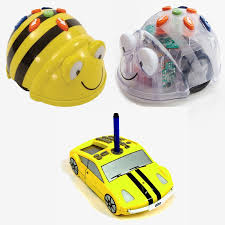Beebots and Bluebots

Bee-bots and Blue-bots - programmable robots designed for young children. Activities could include mazes, writing words (eg name or sight words) on an alphabet map, drawing, rescue missions, visiting countries or places on a map, shape walks etc.
Bee-bot: A yellow bee-shaped robot. Buttons on the back are used to programme the robot to go forward, back, left right or turn 90 degrees left or right. A good introduction to robots and computational thinking. Have students plan their code on paper or whiteboards before taking their turn with the robot. A free Bee-bot iPad app is available that allows students to practice coding Bee-bot without the robot through a series of challenges. Good for Year 1/2 as an introduction but the Blue-bot can do the same things and more.
Blue-bot is similar to the Bee-bot but with more advanced features. It is clear so students can see inside. Available from Sitech (cheapest), MTA and PBTech - need to order online. The Blue-bot is also programmable via an app on an i-pad, Android device, Mac, PC and if your Chromebook is app capable then the Chrome app. In addition to 90 degree turns it also does 45 degrees if you use the app. It has a repetition function in the app and some built-in challenges. You can also draw in the app. The path drawn in the app is different to that drawn if you tape a pen to the Blue-bot. You don't need a blue-bot to use the app.
If controlling using the app I advise turning Bluetooth off except when you are directly controlling it as it can accidentally link to the wrong Blue-bot. I have even noticed this happen if classes next door (or above or below) are using the app with bluetooth enabled. If your robot suddenly starts doing it's own thing that is the most likely reason. This is not an issue just with Bluebot, some other bluetooth-controlled robots may also encounter this.
A tactile reader is also available which enable code tiles to be placed in a reader to avoid use of screens if desired.
Bee-bot: A yellow bee-shaped robot. Buttons on the back are used to programme the robot to go forward, back, left right or turn 90 degrees left or right. A good introduction to robots and computational thinking. Have students plan their code on paper or whiteboards before taking their turn with the robot. A free Bee-bot iPad app is available that allows students to practice coding Bee-bot without the robot through a series of challenges. Good for Year 1/2 as an introduction but the Blue-bot can do the same things and more.
Blue-bot is similar to the Bee-bot but with more advanced features. It is clear so students can see inside. Available from Sitech (cheapest), MTA and PBTech - need to order online. The Blue-bot is also programmable via an app on an i-pad, Android device, Mac, PC and if your Chromebook is app capable then the Chrome app. In addition to 90 degree turns it also does 45 degrees if you use the app. It has a repetition function in the app and some built-in challenges. You can also draw in the app. The path drawn in the app is different to that drawn if you tape a pen to the Blue-bot. You don't need a blue-bot to use the app.
If controlling using the app I advise turning Bluetooth off except when you are directly controlling it as it can accidentally link to the wrong Blue-bot. I have even noticed this happen if classes next door (or above or below) are using the app with bluetooth enabled. If your robot suddenly starts doing it's own thing that is the most likely reason. This is not an issue just with Bluebot, some other bluetooth-controlled robots may also encounter this.
A tactile reader is also available which enable code tiles to be placed in a reader to avoid use of screens if desired.
|
Scratch Bee-bot Safety game Supporting resources and unplugged and physical Bee-bot versions Download resources You will need to register.
Beebot command cards Resource Bee-Bot mat blank square Resource Bee-Bot image – Fake-Bot Bluebot Challenges site Various mats are available to use with the robots. I recommend the transparent pocket maps as you can add your own cards to them or the Primo Toys Maps made for Cubetto will work and are a lot cheaper than the Bluebot ones. Another alternative is to create your own maps by ruling 15cm squares (Bluebot and Beebot). You can use stiff paper (don't fold it) or card but if you have any thermal-backed drapes then they make excellent mats, just rule your grid on the thermal backing side and roll up to store. The app also has various maps in it and you don't need a robot to use it. |
|
